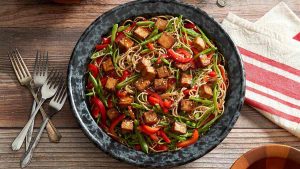by Erin MacGregor, RD howtoeat.ca
Try meal prepping for the week ahead with this meal. Package the crispy tofu noodle bowl into 4 separate food storage containers to enjoy for a quick grab-and-go lunch.
Crispy Tofu Noodle Bowl
Ingredients
Crispy Tofu
- 1 Tbsp soy sauce
- 2 tsp canola oil
- 2 Tbsp cornstarch
- 2/3 lb block of extra firm tofu, drained, pressed and cut into 1 1/4 inch (3 cm) cubes
Dressing
- 1/4 cup canola oil
- 2 Tbsp soy sauce
- 2 Tbsp rice vinegar
- 2 tsp sesame oil
- 1 Tbsp liquid honey
Pasta and Vegetables
- 2/3 lb whole grain long noodles (whole wheat or buckwheat)
- 1 red bell pepper, thinly sliced
- 2 cups sugar snap peas, sliced
- 2 green onions, thinly sliced
- 1 tsp toasted sesame seeds
Instructions
- Crispy Tofu: Preheat oven to 400°F (200°C). Transfer tofu into a large zipper bag. In a small bowl, whisk together soy sauce, canola oil and corn starch. If needed, add a little more soy sauce, 1/2 tsp (2 mL) at a time, if the mixture is to pasty. Pour into freezer bag and gently jostle bag to evenly coat tofu. Transfer tofu onto a parchment-lined baking sheet. Bake for 25 minutes, flipping halfway through until golden brown. Cool slightly.
- Dressing: Meanwhile, in a small bowl, add all ingredients for dressing and whisk to combine.
- Pasta and Vegetables: Prepare noodles according to package directions. Rinse noodles with cold water and strain thoroughly. Toss cooled noodles with half the dressing. Arrange noodles on the bottom of a large serving platter or individual bowls. Top with bell pepper, peas and crispy tofu. Sprinkle with green onion, sesame seeds, and drizzle platter with remaining dressing.
Soybeans can be used to make food products such as tofu, soy milk and various dairy and meat substitutes. It is also used in fermented foods like miso and tempeh, which are gaining popularity right here in Canada. Soybeans are a good source of fibre, plant protein, vitamin C, thiamin, folate, calcium, magnesium, phosphorus, potassium and manganese.
Farmers have always had to control weeds when growing soybeans and historically they did this by ploughing their fields to remove weeds. Not only was this a time-consuming practice but it also degraded the soil and made it much more susceptible to wind and water erosion. And having to run equipment over fields to plough for weeds burned fuel and created greenhouse gas emissions.
Soybean production in Canada changed pretty dramatically in the late 1990s when herbicide-tolerant soybeans came onto the market. With herbicide tolerant crops, farmers are able to practice what is called conservation tillage. An herbicide-tolerant crop means that the herbicide farmers use to kill weeds does not harm the crop. The crop is protected without having to plough the soil, which leaves nutrients and water in the soil and increases soil fertility. It also means fewer passes over the fields with equipment, which reduces fuel use and GHG emissions.
Canadian farmers have overwhelmingly embraced biotech varieties of soybeans (often referred to as GMOs) because of the clear benefits they deliver. About 80 per cent of soybeans grown in Canada are herbicide-tolerant. Without pesticides and biotechnology, Canadian farmers would produce about 33 per cent less soybeans. This technology allows farmers to be as productive as possible on existing land, without needing additional land, which leaves valuable wildlife habitat intact.




 Thai Pumpkin Soup with Spiced Pumpkin Seeds
Thai Pumpkin Soup with Spiced Pumpkin Seeds